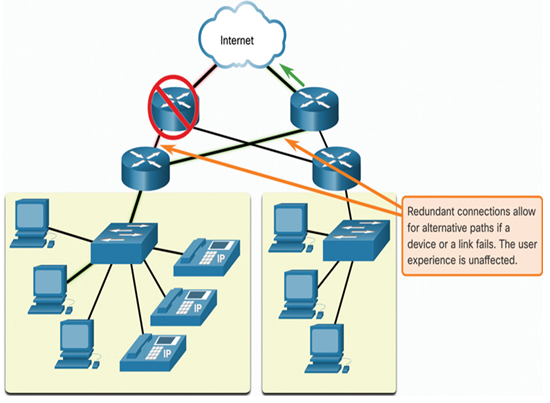A fault tolerant network is one that limits the number of affected devices during a failure. It is built to allow quick recovery when such a failure occurs. These networks depend on multiple paths between the source and destination of a message. If one path fails, the messages are instantly sent over a different link. Having multiple paths to a destination is known as redundancy.
Implementing a packet-switched network is one way that reliable networks provide redundancy. Packet switching splits traffic into packets that are routed over a shared network. A single message, such as an email or a video stream, is broken into multiple message blocks, called packets. Each packet has the necessary addressing information of the source and destination of the message. The routers within the network switch the packets based on the condition of the network at that moment. This means that all the packets in a single message could take very different paths to the same destination. In Figure 18-1, the user is unaware and unaffected by the router that is dynamically changing the route when a link fails.

Figure 18-1 Fault Tolerant Design
A scalable network expands quickly to support new users and applications. It does this without degrading the performance of services that are being accessed by existing users. Figure 18-2 shows how a new network is easily added to an existing network. These networks are scalable because the designers follow accepted standards and protocols. This lets software and hardware vendors focus on improving products and services without having to design a new set of rules for operating within the network.

Figure 18-2 Scalable Design
Quality of Service (QoS) is an increasing requirement of networks today. New applications available to users over networks, such as voice and live video transmissions, create higher expectations for the quality of the delivered services. Have you ever tried to watch a video with constant breaks and pauses? As data, voice, and video content continue to converge onto the same network, QoS becomes a primary mechanism for managing congestion and ensuring reliable delivery of content to all users.
Congestion occurs when the demand for bandwidth exceeds the amount available. Network bandwidth is measured in the number of bits that can be transmitted in a single second, or bits per second (bps). When simultaneous communications are attempted across the network, the demand for network bandwidth can exceed its availability, creating network congestion.
When the volume of traffic is greater than what can be transported across the network, devices will hold the packets in memory until resources become available to transmit them. In Figure 18-3, one user is requesting a web page, and another is on a phone call. With a QoS policy in place, the router can manage the flow of data and voice traffic, giving priority to voice communications if the network experiences congestion. The focus of QoS is to prioritize time-sensitive traffic. The type of traffic, not the content of the traffic, is what is important.

Figure 18-3 QoS Design
